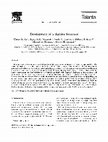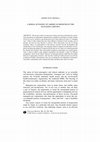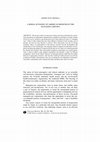PEER-REVIEWED SCHOLARSHIP by Robert H Sprinkle
Archives of Pediatrics & Adolescent Medicine, 1986
\s=b\Few studies have been published about analgesic management practices during sickle cell pain... more \s=b\Few studies have been published about analgesic management practices during sickle cell pain crisis. Therefore, we reviewed the records of all hospi-talized children with this complication during a recent five-year period. The 38 patients (98 painful episodes) who re-ceived ...
The American Historical Review, 1996
... Lown, a cardiac electrophysiol-ogist, had taken a broader view of his chief research interest... more ... Lown, a cardiac electrophysiol-ogist, had taken a broader view of his chief research interest, sudden death ... A world movement of physicians is now emerging. . . ... THE PHYSICIAN'S OATH Medical oaths and codes are intended to state the fundamental values of the profession. ...

Analytica Chimica Acta, 1998
A novel microfabricated amperometric microcell is used for total creatine kinase (CK) activity de... more A novel microfabricated amperometric microcell is used for total creatine kinase (CK) activity determination. The microcell employs a photolithograpically prepared¯at form electrode pair for detection. The enzyme-catalyzed reaction takes place in a thin liquid ®lm, supported by a replaceable porous, hydrophillic membrane, resting on the working electrode surface. Simple, two electrode, amperometry was used, to avoid overvoltage shocks caused by``open'' circuits. An electrochemically prepared size-exclusion membrane was utilized on the working electrode to provide selectivity for the amperometric detection of hydrogen peroxide. Two different analytical reaction sequences following the CK catalyzed creatine phosphate hydrolysis were investigated. Both result in hydrogen peroxide production. The rate of hydrogen peroxide production is proportional to the total CK activity, and it is followed after the dispensation of sample into the microcell. The slope of the amperometric current±time curve is evaluated as the analytical signal. #

Talanta, 1998
A microfabricated, flat form, amperometric microcell (microchip) is used in a simple, two-electro... more A microfabricated, flat form, amperometric microcell (microchip) is used in a simple, two-electrode arrangement for putrescine oxidase enzyme activity determinations. The cell contains a platinum microdisk working electrode and an Ag/AgCl reference electrode covered by a porous, hydrophilic membrane. An electrochemically-prepared size-exclusion layer is applied on the working electrode surface, to avoid the effect of electroactive interferences in the sample. The hydrophilic membrane, resting on the bottom of the cell, is soaked with a small volume of buffered substrate solution and a few mul enzyme containing sample solution is dispensed over the electrodes. During the enzyme activity measurement a catalytic reaction takes place in the membrane-supported liquid film over the working electrode surface. The hydrogen peroxide produced in the reaction is detected amperometrically. The amperometric current-time curves are used for evaluation. In our work putrescine was used as a substrate to determine the unknown putrescine oxidase enzyme activity of the sample. Elevated diamine oxidase enzyme activity in the vaginal milieu can indicate premature rupture of the amniotic membrane. Results with membrane discs, containing all the necessary chemicals in solid or lyophilized form, are very encouraging with respect of a single use, 'reagentless' biosensor for home care.

BioScience, 2003
The life-sciences community has grown increasingly concerned that dangerous microbes or their pro... more The life-sciences community has grown increasingly concerned that dangerous microbes or their products might be mishandled or misused, with serious harm done to human or ecosystem health locally, regionally, or globally. The community has sought to address this concern in cooperation with responsible governments, but it has also sought to act in ways not chiefly dependent on governmental initiatives or intergovernmental agreements. Concurrently, it has sought to obviate policies materially restricting scientific, entrepreneurial, or commercial freedoms. I ask whether the enhancement of biosecurity and the advancement of bioscience should be accepted as divergent or might yet be made complementary, so as to be accomplished jointly. To encourage discussion of this latter possibility, I propose an institutional innovation, a transnational, nongovernmental life-sciences organization called here "The Biosecurity Trust.
Analytica Chimica Acta, 2003
... Susana Campuzano, Beatriz Serra, María Pedrero, F. Javier Manuel de Villena and José M. Pinga... more ... Susana Campuzano, Beatriz Serra, María Pedrero, F. Javier Manuel de Villena and José M. Pingarrón Corresponding Author Contact Information , E-mail The ... Styrene(divinylbenzene) SPE cartridges (Envi-chrom P, 0.5 g/6 ml, Supelco) were used for estimation of the phenolic ...
Annals of the New York Academy of Sciences, 1992
BioScience, 2008
BioOne Complete (complete.BioOne.org) is a full-text database of 200 subscribed and open-access t... more BioOne Complete (complete.BioOne.org) is a full-text database of 200 subscribed and open-access titles in the biological, ecological, and environmental sciences published by nonprofit societies, associations, museums, institutions, and presses.
Environment and Development Economics, 1996
Our environment is complex, but it is understandable through rational investigation, and it is no... more Our environment is complex, but it is understandable through rational investigation, and it is not to be feared. So wrote Titus Lucretius Carus of the nature of things some thirty human lifetimes ago—not so long, really. About species evolution Lucretius thought much, guessed well, and worried little. About microparasitic evolution he knew nothing. Would he have feared it? Should we fear it now?

Archives of Pediatrics & Adolescent Medicine, 1994
To determine whether and where universal neonatal screening for hemoglobinopathies, chiefly sickl... more To determine whether and where universal neonatal screening for hemoglobinopathies, chiefly sickle-cell disease, could be performed at socially acceptable costs. We made projections of the cost-effectiveness of nonuniversal and universal sickle-cell disease screening throughout the United States. We then compared the cost-effectiveness of universal sickle-cell disease screening with that of universal phenylketonuria screening. Finally, we asked if "high-cost" states, that is, those in which the cost of finding a case of sickle-cell disease exceeded one half the cost of finding a case of phenylketonuria, could enhance their cost-effectiveness by joining demographically complementary states in screening cooperatives. If all states conducted independent screening and if the value of finding a case of sickle-cell disease were no more than one half that of finding a case of phenylketonuria, seven of the 19 states that do not currently conduct universal screening for hemoglobinopathies would begin to do so, but six of the 34 that currently do so would stop. Of the six that would stop, three have already formed a screening cooperative, reducing their projected average costs for finding either sickle-cell disease or phenylketonuria or both; the other three could similarly improve cost-effectiveness through cooperative arrangements. Nineteen states realize economies of scale in six cooperative groups; more could do so. Universal neonatal hemoglobinopathy screening can be made available at socially acceptable costs to the citizens of demographically various states.

Journal of Health Politics, Policy and Law, 1994
Standard models of patient demand for health care and health care suppliers' response to ... more Standard models of patient demand for health care and health care suppliers' response to that demand imply that some manner of manipulation of the prices faced by patients must be chief among the mechanisms of systemic cost control. However convenient econometrically, these standard models cannot reflect the complexity of patient demand behavior, and they say little about the predominant causes of health-care cost escalation. This paper describes a richer Jevonian political-economic model that sensibly portrays patient demand and physician and corporate supply behaviors and suggests a range of cost-controlling and care-enhancing compensatory steps, some professional, some societal. This new model implies that reformers in the United States could take respectful advantage of the fundamentally self-regulating nature of patient demand for health care by shifting their attention away from its further discouragement and toward the modulation of other factors.

Politics and the Life Sciences, 2014
BackgroundWhen in May 1983 the acquired immunodeficiency syndrome (AIDS) was first securely attri... more BackgroundWhen in May 1983 the acquired immunodeficiency syndrome (AIDS) was first securely attributed to a virus, eventually called the human immunodeficiency virus (HIV), many controversies arose. Among these was one centering on HIV's origin. A startling hypothesis, called here the “HIV-from-Fort-Detrick myth,” asserted that HIV had been a product, accidental or intentional, of bioweaponry research. While its earliest identifiable contributors were in the West, this myth's most dynamic propagators were in the East. The Soviet security service, the KGB, took “active measures” to create and disseminate AIDS disinformation beginning no later than July 1983 and ending no earlier than October 1987. The East German security service, a complex bureaucracy popularly known as “the Stasi,” was involved, too, but how early, how deeply, how uniformly, how ably, and how successfully has not been clear. Following German reunification, claims arose attributing to the Stasi the masterful...

Talanta, 1997
An amperometric diamine sensor is developed for clinical applications in diagnosis of bacterial v... more An amperometric diamine sensor is developed for clinical applications in diagnosis of bacterial vaginosis (BV). The sensor is based on crosslinked putrescine oxidase (PUO) which catalyzes the conversion of diamines (mainly putrescine and cadaverine) to products including hydrogen peroxide. The hydrogen peroxide is detected anodically at platinum electrode polarized at 0.5 V versus Ag/AgCl. Platinum-plated gold electrodes used as a substrate for the sensor construction, are batch-fabricated on a flexible polyimide foil (Kapton @, DuPont). A three-electrode cell configuration is used in all amperometric measurements. The sensor construction is based on three layers: an inner layer to reject the interference effect of oxidizable molecules, an outer diffusion controlling layer, and in addition, an enzyme middle layer. The enzyme layer was immobilized by crosslinking PUO with bovine serum albumin (BSA) using glutaraldehyde (GA). An optimization study of the enzyme solution composition was carried out. With the optimized enzyme layer, the biosensor showed a very high sensitivity and fast response time of ca. 20 s. The sensor has a linear dynamic range from (0.5300 PM) for putrescine that covers the expected biological levels of the analyte. Details on sensor fabrication and characterization are given in the present work. 0 1997 Elsevier Science B.V.
Profession of Conscience, 1994
Philosophy and Medicine, 2010
Arguments by analogy are prominent features of bioethical literature. In the United States, dispo... more Arguments by analogy are prominent features of bioethical literature. In the United States, dispositive analogies have greatly affected health policy and health law and, sometimes, bioethical reasoning itself. Analogical argument has deep roots and the effort to avoid its misapplication a long history. An alternative approach, exemplified by clinical-ethical practice in the Hippocratic and phenomenological traditions, is presented and recommended.

Theoretical medicine and bioethics, 2001
The moral economy of American medicine has been transformed by contentious innovations in organiz... more The moral economy of American medicine has been transformed by contentious innovations in organization, administration, regulation, and finance. In many settings old fee-for-service incentives and disincentives have been replaced by those of "managed care", while in other settings they have been diluted or distorted. In the everyday care of patients, old and new may alternate or interact. These innovations may also be having secondary effects on participation in life-sciences research and the development and employment of new technologies, discouraging collective support for preliminary investigation and delaying adoption of improved goods and services until cost-reducing potential has already been realized. This motivational complexity, particularly in its moral dimensions, is hard to address using standard assumptions and methods. I argue for different assumptions, based on the clinical behavior of individual patients rather than the market behavior of aggregated consume...
Politics and the life sciences : the journal of the Association for Politics and the Life Sciences, 2001
The age of puberty in many populations has declined steeply over recent centuries and may be decl... more The age of puberty in many populations has declined steeply over recent centuries and may be declining still. Consequently, today's children tend to experience the hormonal stresses of rapid development at younger ages than did their ancestors, around whose later, if not more gradual, maturation traditional behavioral expectations formed. Little has been made of this "rush to puberty" outside the life sciences. This article reviews its historical documentation, scholarly appreciation, epidemiological correlations, putative physiological and environmental explanations, sociological implications, and largely latent politics.

Review of International Studies, 1999
Though usually assumed by scholars of international relations to have been one-of-a-kind, the Col... more Though usually assumed by scholars of international relations to have been one-of-a-kind, the Cold War—the global East-West rivalry that ended with the peaceful dissolution of the Soviet Union—resembled in many of its features an earlier match usually assumed by scholars of American history to have been entirely exceptional: the continental North-South rivalry that ended with the War Between the States. Each was a contest of ideologically ambitious, institutionally immiscible, and territorially extensionist socioeconomic systems. Each rivalry evolved a mechanism for the procrastination of conflict. In both cases this mechanism was initially deliberative—based on debate. It remained deliberative in the North-South case, which deteriorated from cooperation to catastrophe, but it switched from deliberative to confrontational—based on threat—in the East-West case, which ended in voluntary unilateral abandonment of ideology, institutions, and territory. The irony of the outcomes of these...
Philosophy Public Policy Quarterly, 1997

Theor Med Bioeth, 2001
The moral economy of American medicine has been transformed by contentious innovations in organiz... more The moral economy of American medicine has been transformed by contentious innovations in organization, administration, regulation, and finance. In many settings old fee-for-service incentives and disincentives have been replaced by those of "managed care", while in other settings they have been diluted or distorted. In the everyday care of patients, old and new may alternate or interact. These innovations may also be having secondary effects on participation in life-sciences research and the development and employment of new technologies, discouraging collective support for preliminary investigation and delaying adoption of improved goods and services until cost-reducing potential has already been realized. This motivational complexity, particularly in its moral dimensions, is hard to address using standard assumptions and methods. I argue for different assumptions, based on the clinical behavior of individual patients rather than the market behavior of aggregated consumers, and I describe a different method, based on an old idea in political economy. I then present a new way to explain the core obligations of clinicians, researchers, and planners and to interpret the policy problems they must now share.











Uploads
PEER-REVIEWED SCHOLARSHIP by Robert H Sprinkle